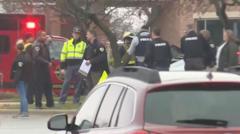The recent death of cyclist Paul Varry in Paris has ignited a heated debate between cyclists and motorists, highlighting the city's evolving transportation policies under Mayor Anne Hidalgo. As cycling advocates demand increased safety measures, tensions rise over the changing dynamics of city travel.
Tragedy on Two Wheels: The Clash of Cyclists and Motorists in Paris

Tragedy on Two Wheels: The Clash of Cyclists and Motorists in Paris
The death of cyclist Paul Varry reveals deep divisions in Paris as Mayor Anne Hidalgo intensifies her campaign against cars in the city.
The recent tragic death of cyclist Paul Varry, run over by an SUV in a designated bike lane near La Madeleine, has sent shockwaves through Paris, a city known for its expanding cycling infrastructure. Prosecutors suspect the incident may have been a deliberate act of road rage, prompting a murder investigation. Varry, a 27-year-old cycling advocate, was mourned by Mayor Anne Hidalgo, who emphasized her commitment to reducing car use in the city during a poignant City Council session. Hidalgo, representing the Socialist Party, expressed her frustration: “I am truly angry. The future does not belong to cars.”
Varry's tragic passing has sparked significant public outcry, shedding light on the perilous circumstances cyclists often face in a city embracing bikes and cycling lanes more than ever. Simultaneously, it amplifies the mounting frustrations among drivers who feel increasingly marginalized as the city adapts policies aimed at restricting vehicle movement, speed, and parking, leading to friction between the two communities.
In light of Varry's death, cycling advocates are demanding stronger protections from aggressive driving. However, some argue that certain cyclists, too, engage in reckless behavior, contributing to safety concerns. This growing divide is exacerbated by new regulations preventing cars from driving through four central arrondissements of Paris, pushing the debate on whether Hidalgo's anti-car approach is feasible or beneficial for everyone, particularly for lower-income drivers and business owners.
Overall, the narrative surrounding the cycling versus driving conflict is complicated by socioeconomic factors, with critics asserting that the policies favor the affluent who reside in the city center, leaving others to navigate the fallout. As Paris continues to evolve its approach to transportation, the discussions prompted by Varry's death show no signs of abating.
Varry's tragic passing has sparked significant public outcry, shedding light on the perilous circumstances cyclists often face in a city embracing bikes and cycling lanes more than ever. Simultaneously, it amplifies the mounting frustrations among drivers who feel increasingly marginalized as the city adapts policies aimed at restricting vehicle movement, speed, and parking, leading to friction between the two communities.
In light of Varry's death, cycling advocates are demanding stronger protections from aggressive driving. However, some argue that certain cyclists, too, engage in reckless behavior, contributing to safety concerns. This growing divide is exacerbated by new regulations preventing cars from driving through four central arrondissements of Paris, pushing the debate on whether Hidalgo's anti-car approach is feasible or beneficial for everyone, particularly for lower-income drivers and business owners.
Overall, the narrative surrounding the cycling versus driving conflict is complicated by socioeconomic factors, with critics asserting that the policies favor the affluent who reside in the city center, leaving others to navigate the fallout. As Paris continues to evolve its approach to transportation, the discussions prompted by Varry's death show no signs of abating.






















